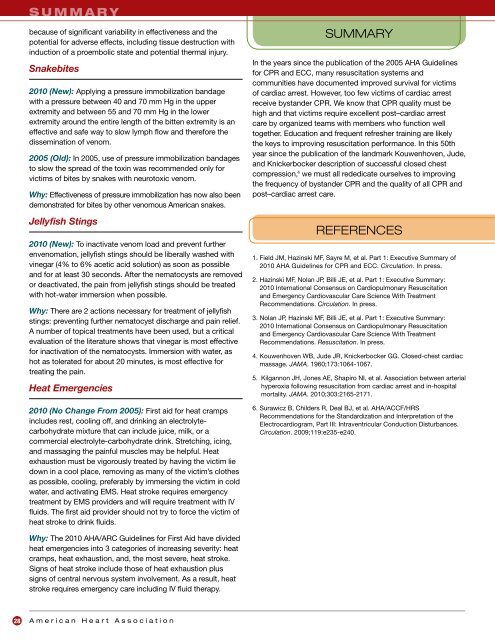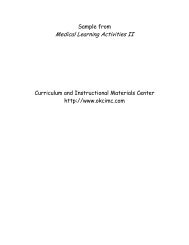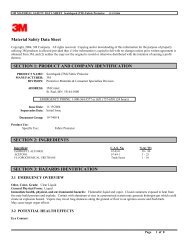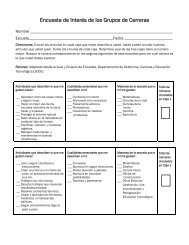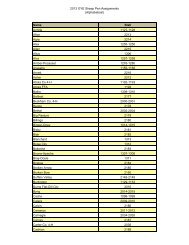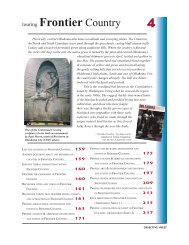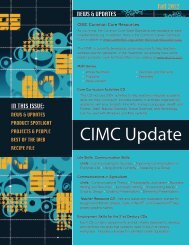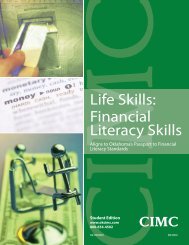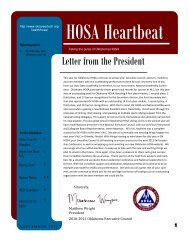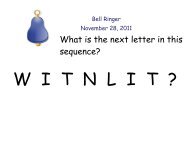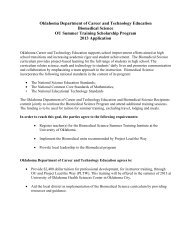Highlights of the 2010 Guidelines for CPR and ECC - ECC Guidelines
Highlights of the 2010 Guidelines for CPR and ECC - ECC Guidelines
Highlights of the 2010 Guidelines for CPR and ECC - ECC Guidelines
You also want an ePaper? Increase the reach of your titles
YUMPU automatically turns print PDFs into web optimized ePapers that Google loves.
s u m m a r y<br />
because <strong>of</strong> significant variability in effectiveness <strong>and</strong> <strong>the</strong><br />
potential <strong>for</strong> adverse effects, including tissue destruction with<br />
induction <strong>of</strong> a proembolic state <strong>and</strong> potential <strong>the</strong>rmal injury.<br />
Snakebites<br />
<strong>2010</strong> (New): Applying a pressure immobilization b<strong>and</strong>age<br />
with a pressure between 40 <strong>and</strong> 70 mm Hg in <strong>the</strong> upper<br />
extremity <strong>and</strong> between 55 <strong>and</strong> 70 mm Hg in <strong>the</strong> lower<br />
extremity around <strong>the</strong> entire length <strong>of</strong> <strong>the</strong> bitten extremity is an<br />
effective <strong>and</strong> safe way to slow lymph flow <strong>and</strong> <strong>the</strong>re<strong>for</strong>e <strong>the</strong><br />
dissemination <strong>of</strong> venom.<br />
2005 (Old): In 2005, use <strong>of</strong> pressure immobilization b<strong>and</strong>ages<br />
to slow <strong>the</strong> spread <strong>of</strong> <strong>the</strong> toxin was recommended only <strong>for</strong><br />
victims <strong>of</strong> bites by snakes with neurotoxic venom.<br />
Why: Effectiveness <strong>of</strong> pressure immobilization has now also been<br />
demonstrated <strong>for</strong> bites by o<strong>the</strong>r venomous American snakes.<br />
Jellyfish Stings<br />
<strong>2010</strong> (New): To inactivate venom load <strong>and</strong> prevent fur<strong>the</strong>r<br />
envenomation, jellyfish stings should be liberally washed with<br />
vinegar (4% to 6% acetic acid solution) as soon as possible<br />
<strong>and</strong> <strong>for</strong> at least 30 seconds. After <strong>the</strong> nematocysts are removed<br />
or deactivated, <strong>the</strong> pain from jellyfish stings should be treated<br />
with hot-water immersion when possible.<br />
Why: There are 2 actions necessary <strong>for</strong> treatment <strong>of</strong> jellyfish<br />
stings: preventing fur<strong>the</strong>r nematocyst discharge <strong>and</strong> pain relief.<br />
A number <strong>of</strong> topical treatments have been used, but a critical<br />
evaluation <strong>of</strong> <strong>the</strong> literature shows that vinegar is most effective<br />
<strong>for</strong> inactivation <strong>of</strong> <strong>the</strong> nematocysts. Immersion with water, as<br />
hot as tolerated <strong>for</strong> about 20 minutes, is most effective <strong>for</strong><br />
treating <strong>the</strong> pain.<br />
Heat Emergencies<br />
<strong>2010</strong> (No Change From 2005): First aid <strong>for</strong> heat cramps<br />
includes rest, cooling <strong>of</strong>f, <strong>and</strong> drinking an electrolytecarbohydrate<br />
mixture that can include juice, milk, or a<br />
commercial electrolyte-carbohydrate drink. Stretching, icing,<br />
<strong>and</strong> massaging <strong>the</strong> painful muscles may be helpful. Heat<br />
exhaustion must be vigorously treated by having <strong>the</strong> victim lie<br />
down in a cool place, removing as many <strong>of</strong> <strong>the</strong> victim’s clo<strong>the</strong>s<br />
as possible, cooling, preferably by immersing <strong>the</strong> victim in cold<br />
water, <strong>and</strong> activating EMS. Heat stroke requires emergency<br />
treatment by EMS providers <strong>and</strong> will require treatment with IV<br />
fluids. The first aid provider should not try to <strong>for</strong>ce <strong>the</strong> victim <strong>of</strong><br />
heat stroke to drink fluids.<br />
SUMMARY<br />
In <strong>the</strong> years since <strong>the</strong> publication <strong>of</strong> <strong>the</strong> 2005 AHA <strong>Guidelines</strong><br />
<strong>for</strong> <strong>CPR</strong> <strong>and</strong> <strong>ECC</strong>, many resuscitation systems <strong>and</strong><br />
communities have documented improved survival <strong>for</strong> victims<br />
<strong>of</strong> cardiac arrest. However, too few victims <strong>of</strong> cardiac arrest<br />
receive byst<strong>and</strong>er <strong>CPR</strong>. We know that <strong>CPR</strong> quality must be<br />
high <strong>and</strong> that victims require excellent post–cardiac arrest<br />
care by organized teams with members who function well<br />
toge<strong>the</strong>r. Education <strong>and</strong> frequent refresher training are likely<br />
<strong>the</strong> keys to improving resuscitation per<strong>for</strong>mance. In this 50th<br />
year since <strong>the</strong> publication <strong>of</strong> <strong>the</strong> l<strong>and</strong>mark Kouwenhoven, Jude,<br />
<strong>and</strong> Knickerbocker description <strong>of</strong> successful closed chest<br />
compression, 4 we must all rededicate ourselves to improving<br />
<strong>the</strong> frequency <strong>of</strong> byst<strong>and</strong>er <strong>CPR</strong> <strong>and</strong> <strong>the</strong> quality <strong>of</strong> all <strong>CPR</strong> <strong>and</strong><br />
post–cardiac arrest care.<br />
REFERENCES<br />
1. Field JM, Hazinski MF, Sayre M, et al. Part 1: Executive Summary <strong>of</strong><br />
<strong>2010</strong> AHA <strong>Guidelines</strong> <strong>for</strong> <strong>CPR</strong> <strong>and</strong> <strong>ECC</strong>. Circulation. In press.<br />
2. Hazinski MF, Nolan JP, Billi JE, et al. Part 1: Executive Summary:<br />
<strong>2010</strong> International Consensus on Cardiopulmonary Resuscitation<br />
<strong>and</strong> Emergency Cardiovascular Care Science With Treatment<br />
Recommendations. Circulation. In press.<br />
3. Nolan JP, Hazinski MF, Billi JE, et al. Part 1: Executive Summary:<br />
<strong>2010</strong> International Consensus on Cardiopulmonary Resuscitation<br />
<strong>and</strong> Emergency Cardiovascular Care Science With Treatment<br />
Recommendations. Resuscitation. In press.<br />
4. Kouwenhoven WB, Jude JR, Knickerbocker GG. Closed-chest cardiac<br />
massage. JAMA. 1960;173:1064-1067.<br />
5. Kilgannon JH, Jones AE, Shapiro NI, et al. Association between arterial<br />
hyperoxia following resuscitation from cardiac arrest <strong>and</strong> in-hospital<br />
mortality. JAMA. <strong>2010</strong>;303:2165-2171.<br />
6. Surawicz B, Childers R, Deal BJ, et al. AHA/ACCF/HRS<br />
Recommendations <strong>for</strong> <strong>the</strong> St<strong>and</strong>ardization <strong>and</strong> Interpretation <strong>of</strong> <strong>the</strong><br />
Electrocardiogram, Part III: Intraventricular Conduction Disturbances.<br />
Circulation. 2009;119:e235-e240.<br />
Why: The <strong>2010</strong> AHA/ARC <strong>Guidelines</strong> <strong>for</strong> First Aid have divided<br />
heat emergencies into 3 categories <strong>of</strong> increasing severity: heat<br />
cramps, heat exhaustion, <strong>and</strong>, <strong>the</strong> most severe, heat stroke.<br />
Signs <strong>of</strong> heat stroke include those <strong>of</strong> heat exhaustion plus<br />
signs <strong>of</strong> central nervous system involvement. As a result, heat<br />
stroke requires emergency care including IV fluid <strong>the</strong>rapy.<br />
28<br />
A m e r i c a n H e a r t A s s o c i a t i o n


